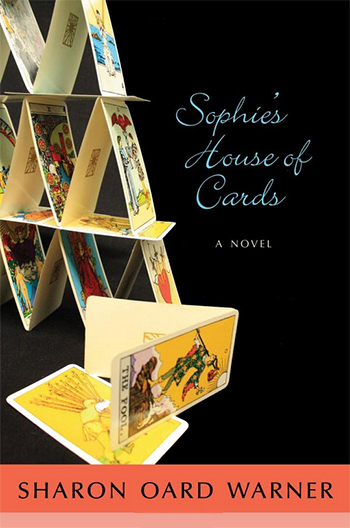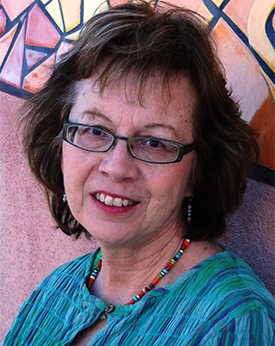
This week we ask author, UNM English professor, and founder and director of the Taos Summer Writer’s Conference Sharon Oard Warner about her intriguing new novel Sophie’s House of Cards, published this year by the University of New Mexico Press.
New Mexico Mercury: One of the many fascinating aspects of this novel is the use of tarot imagery as an organizing principle for the story. How did you come to that idea?
 Sharon Oard Warner: Many years ago, I listened to a fellow writer, Wayne Johnson, talk about his writing aspirations. He said he wanted to write a novel that took its structure from a metaphor or recurring motif. Johnson offered the example of Annie Proulx’s Shipping News, wherein the chapter titles are taken from the names of sailor’s knots. Chapter 1, for instance, is called “Quoyle,” which means a coil of rope. Proulx included descriptions from a book called The Ashley Book of Rope. A quoyle is one layer of rope arranged neatly, so that “it may be walked on if necessary.” Would it surprise you to learn that the main character is something of a doormat?
Sharon Oard Warner: Many years ago, I listened to a fellow writer, Wayne Johnson, talk about his writing aspirations. He said he wanted to write a novel that took its structure from a metaphor or recurring motif. Johnson offered the example of Annie Proulx’s Shipping News, wherein the chapter titles are taken from the names of sailor’s knots. Chapter 1, for instance, is called “Quoyle,” which means a coil of rope. Proulx included descriptions from a book called The Ashley Book of Rope. A quoyle is one layer of rope arranged neatly, so that “it may be walked on if necessary.” Would it surprise you to learn that the main character is something of a doormat?
Whitney Otto’s How to Make an American Quilt is structured similarly, except that in the case of Quilt the subplots are stitched together using imagery from the craft of quilt-making. I loved Otto’s novel, and it occurred to me then—as Wayne Johnson talked—that I could write a novel structured around a tarot card reading.
I happened to know something about the cards, you see. When I was nineteen years old, I took a semester-long class on tarot at the Marin County Community College in California. I held onto my cards for decades, kept them safe in a pine box. Once I decided to write the book, I spilled them out on the carpet and began to reacquaint myself. It took a while; it took a long while. I’m happy to tell you that the house of cards on the cover is constructed from that same set of cards, the Albano-Waite deck I bought for that long-ago class.
NNM: What is it about New Mexico that makes it such a compelling and “logical” location for this story about relationships, non-conformity, and fate?
SOW: Well, the easy answer is that New Mexico is the Land of Enchantment.
A stark and dramatic landscape casts a spell on its inhabitants—we are lulled by the beauty of this state even as we are wary of its volatility. In the book’s first chapter, for instance, I describe the Sleeping Sisters, the five dormant volcanoes that butt up on the western horizon of Albuquerque. The Sisters are sleeping—but they’re not extinct. What’s sleeping can wake; what’s awake can boil over.
So much about the culture here harks to mystery and the unexpected. Even in the smallest things, New Mexico surprises me. I wanted to share that sense of unpredictability with the reader. Where else do dozens of hot air balloons drift over rush-hour traffic? And here’s a small example: The other day I walked out of the Humanities Building on the campus of UNM and encountered a skinny German shepherd resting on the steps of Smith Plaza. Nothing strange about that—but the dog was a resting place for a Macaw, a majestic parrot that was equal parts scarlet and royal blue. The parrot was perfectly at home on the back of the dog! New Mexico is equal parts mayhem and magic—in other words the perfect setting for a book about fate.
NNM: the intimacy and fragility of the relationship between Sophie and her mother Peggy, along with the bee imagery and violence of the early “requeening” of a beehive, set an emotional field for the reader from the very start. Was this a strategy you followed from the beginning, or did the novel evolve? And if so, how did it take shape?
SOW: Beekeeping entered the novel quite by accident. When I began developing the character of Jack Granger, I gave him the hobby of beekeeping because I wanted to like him and I’ve always been drawn to men who keep bees—my grandfather first of all, and since then two male friends. Writing about a man who is a beekeeper gave me a good excuse to take a beekeeping class and to read several books on the subject. Over the years it took me to write the book, I found ways to integrate the beekeeping scenes into the larger thematic framework of the novel. But during those same years, honey bees began dying off or disappearing. In the last several drafts, I incorporated Colony Collapse Disorder into the plot of the novel. I am something of a bee activist these days. Whereas other people are stressing over ISIS and Ebola, I’m more concerned about pesticides and Monsanto.
NNM: What has the response been to this novel so far?
SOW: The best adjective to apply to any novel is engrossing, and I’ve been hearing that word a lot. It’s music to my ears. The novels I most appreciate are those that draw me in and hold me captive—pulling me through the story one sentence, one paragraph, one page at a time. So, I was thrilled to hear from Wally Lamb that the novel is captivating, because that means he didn’t want to put it down. And speaking of Wally, I’ve been pleased and surprised to hear from male readers who liked the novel. I got an e-mail last week from a Taos participant who lives in Houston: “I just finished your novel and it is great. I opted for the paperback version from Amazon and it showed up in Saturday's mail. I read while football played in the background and finished it at noon.” He preferred Sophie to the football game, which means he must have been—there it is, there’s that word—engrossed.
NNM: Did your interaction with other writers at the Taos Summer Writer’s Conference influence your creative process with this book?
SOW: Always and in a multitude of ways, I am inspired by and grateful to the writing community that convenes every July at the Sagebrush Inn in Taos, New Mexico.
Sophie’s House of Cards is available at bookstores or directly from the University of New Mexico Press at http://www.unmpress.com or 800.249.7737.
Book Reading and Signing with Sharon Oard Warner
Thursday, November 20, 2014, 6:00 pm
Collected Works Bookstore & Coffeehouse
202 Galisteo Street
Santa Fe, NM 87501
505-988-4226



Responses to “Five Questions for New Mexico Authors - Sharon Oard Warner”